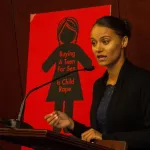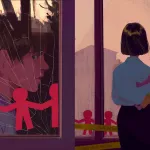Sharday Hamilton, a 28-year-old advocate for foster youth, homeless youth and runaways, still bears her own scars from running.
There’s one near her left knee. She got it as a little girl, running away from her foster mother, who was trying to hit her with a bag of frozen food but who sometimes used a skillet or a baseball bat. There are the burns she suffered when she was forced to sit on a hot stove.
Caseworkers and school counselors didn’t visit Hamilton’s foster home in Harvey, Illinois, or check in with her often enough, recalled Hamilton, now a mentor at the National Network for Youth, a nonprofit focused on youth homelessness. And when they did, she said, they missed signs of abuse. “The system failed me,” she said.
Hamilton sometimes spent nights at her friends’ houses to avoid the violence. Many foster kids in similar situations also flee — and some of them don’t come back for weeks, months or ever. Tens of thousands simply disappear from the foster care system, according to several recent reports, putting them beyond the state’s protection and at high risk of sexual exploitation.
Under federal law, state social service agencies must submit a report to the National Center for Missing & Exploited Children, a nonprofit organization established by Congress in 1984, when a child under their care goes missing. They also are required to notify law enforcement, who report missing children to the National Crime Information Center.
But an audit published earlier this year by the U.S. Department of Health and Human Services found that across 46 states, state agencies failed to report an estimated 34,800 cases of missing foster kids. Cases include children who ran away multiple times. The average age, according to the National Center for Missing & Exploited Children, was 15.
“When it comes to teenagers specifically, most child welfare systems just don’t have the right service array, because systems are often built for babies and younger children,” said consultant and attorney Lisa Pilnik, director of Child & Family Policy Associates, a child welfare consulting and research firm.
“We don’t have enough family placements, and we don’t have family placements that are equipped to meet the needs of teenagers,” she said.
‘A lot of difficulties’
Teens often run away or go missing more than once during their time in foster care. The National Center for Missing & Exploited Children report found that about 40% of foster children who were reported missing went missing multiple times — on average, four times — while in state care.
Black and Native American children are overrepresented in foster care and make up a disproportionate number of missing kids. Hamilton was among those Black children. Studies have shown that states are more likely to remove Black children from their homes, and that racial bias is a factor.
“The foster care system is wrought with a lot of difficulties,” said Gaétane Borders, president of Peas In Their Pods, a nonprofit that advocates for missing children of color. “When you add that to the complexities of missing children, reporting of missing children, and how that intersects with human trafficking and sexual exploitation — it is honestly a complete mess.”
-
More from The 19th
- Teenagers’ detention at Angola prison has brought new attention to Louisiana’s fractured juvenile system
- Illinois will be the first state to eliminate cash bail. Here’s why women led the push for reform.
- College students have never had a roadmap for navigating sexual assault — until now
Recent reports on some states are equally damning. In Georgia, nearly 1,800 children in state care went missing between 2018 and 2022, according to a new analysis conducted by the National Center for Missing & Exploited Children as part of a U.S. Senate panel’s ongoing probe into Georgia’s child welfare system. More than 20% of those were likely trafficked, Samantha Sahl, supervisor of the center’s child sex trafficking recovery services team, said at a subcommittee hearing Monday.
“[The Georgia Division of Family & Children Services] takes seriously the issue of missing or runaway children and has a 14-page policy memo providing detailed instructions to DFCS case workers on how to handle reported missing children,” lawyers for the agency wrote in response to testimony presented to the Senate panel.
“To further bolster our practices, [the agency] will advocate for changes in state law in the upcoming legislative session to allow more information-sharing with [the National Center for Missing & Exploited Children].”
A U.S. Department of Health and Human Services audit of Missouri, released in 2021, found that in 2019, 978 children went missing from the state’s foster care system. Nearly half of the cases reviewed weren’t reported to either law enforcement or the National Center for Missing & Exploited Children.
“There needs to be more oversight and accountability for checking in on these kids that are in out-of-home placements,” said Jessica Seitz, executive director of Missouri KidsFirst, a child abuse prevention nonprofit.
Seeing warning signs
In most states, overburdened, under-supervised caseworkers are hard-pressed to protect all the children they are responsible for monitoring. And when kids go missing, caseworkers often struggle to prevent it from happening again and again.
Amy Robins, forensic services director of the Child Advocacy Center of Northeast Missouri, said social workers and search teams must figure out whether missing foster kids are running from an out-of-home placement or running to someone — perhaps a sex trafficker — who promises them freedom and a better life. Or if the kids are doing both.
“Typically, the part that we miss with this population is we’re not asking the right questions,” Robins said.
Police and school officials also should be trained to recognize when a foster child — or any child — is being abused or trafficked, said Alexandra Miller, deputy director of the Center for Juvenile Justice Reform at Georgetown University.
“There’s definitely a lack of professionals being able to identify what those warning signs are,” Miller said. Law enforcement or school officials might not realize, for example, that burglary or trespassing by teenagers “could be survival crimes or crimes that are tangential to being trafficked and abused,” she said.
Since the scathing 2021 report, Missouri’s Department of Social Services has created a full-time staff position focused on children missing from state care. The state also told Stateline it has a team dedicated to helping local law enforcement agencies investigate and prosecute neglect, sexual abuse and other crimes committed against children.
And a new Missouri law modifies law enforcement’s “missing child” definition to include “persons under 18 years of age, foster children regardless of age, emancipated minors, or homeless youth.” It also requires child welfare authorities to file a police report within two hours of determining that a child under their care is missing.
Florida also recently passed legislation creating a task force focused on finding children missing from foster care.
“A team should be ready to go and hit the ground to find out if these kids are actually on runaway status, or has anybody snatched them,” said Florida Democratic state Rep. Patricia Williams. “It is our job as adults, as the legislators, to put things in place to protect all of our children.”
This summer, an Arizona bill was signed into law that requires the state’s child welfare department to report a missing foster care child to law enforcement within 24 hours. It also requires law enforcement to notify media outlets within 48 hours.
The bill was introduced two weeks after two teenage girls were found dead in a retention basin after running from a group home.
And last week, the U.S. Senate unanimously approved the bipartisan Find and Protect Foster Youth Act. The legislation would require the Department of Health and Human Services to evaluate why states are failing to comply with federal rules and to help them remove those obstacles. The measure now awaits House approval.
Abbi Warmker, the deputy regional inspector general for the U.S. Department of Health and Human Services, said the agency’s Administration for Children and Families must do a better job of holding states accountable for reporting missing foster youth and screening them for sexual exploitation when they are found.
“What we’ve found is that [the Administration for Children and Families] is really good at making sure that states have policies and procedures in place, but they’re not so great at making sure that those policies and procedures are being followed at the state level,” she said.
“The risk for exploitation is so much greater when children are missing from their foster care placements. So, it’s just really critical that there’s oversight at every level — at the state, the local and then also at the federal level.”
Hamilton said her goal as a mentor at the National Network for Youth is to help foster kids advocate for themselves whenever they feel unsafe.
“I want them to know it’s OK to speak up and speak out,” she said. “It was traumatizing, but I’m glad I’m able to live and tell my story.”
Stateline is part of States Newsroom, a nonprofit news network supported by grants and a coalition of donors as a 501c(3) public charity. Stateline maintains editorial independence. Contact Editor Scott S. Greenberger for questions: [email protected]. Follow Stateline on Facebook and Twitter.





